Across 24 countries Pew Research Center surveyed this spring, more people have a positive view of the United States than of China. However, this gap is closing, as views of the U.S. have become more negative while views of China have turned more positive.
In the sections below, we compare international public opinion of the two superpowers, their leaders, their economies and more. All findings are based on surveys of more than 28,000 adults conducted Jan. 8-April 26, 2025.
- Views of the U.S. and China, and how they’ve changed over time
- Views of Trump and Xi, and how they’ve changed over time
- Which country is the world’s leading economy?
- Is the U.S. or China a more important economic partner?
- Which country is a closer ally – or a bigger threat?
Views of the U.S. and China
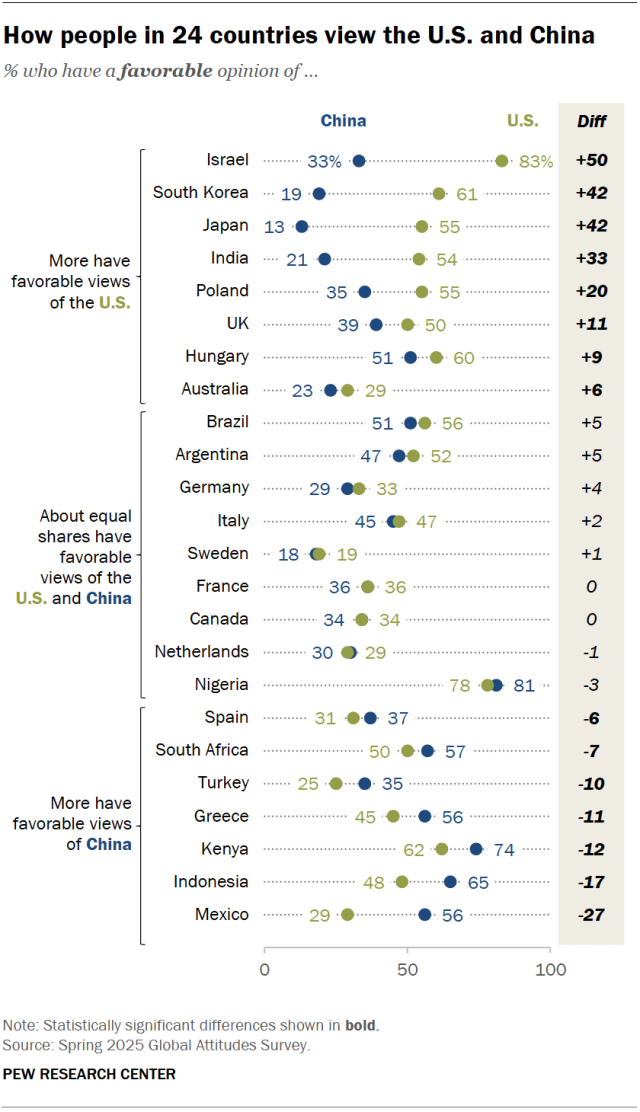
Across the countries surveyed, a median of 49% of adults have a favorable view of the U.S, while a median of 37% have a favorable view of China.
In eight countries, people have a more positive view of the U.S. than China. This is especially the case in Israel, where 83% view the U.S. favorably, compared with 33% who take this stance on China. People in some countries that neighbor China – including South Korea, Japan and India – are also much more likely to see the U.S. than China favorably.
In seven other countries, people have a more positive opinion of China than the U.S. These include the United States’ southern neighbor, Mexico, where 56% of adults view China positively and 29% say the same of the U.S. China gets the better ratings in four other middle-income countries surveyed: South Africa, Turkey, Kenya and Indonesia.
Meanwhile, in nine countries – including five in Europe – views of the U.S. and China are similar. In these European countries, more people tend to have a negative than positive opinion of each nation.
How global views of the U.S. and China have changed over time

In many of the countries surveyed, views of the U.S. have turned significantly more negative over the past year, while views of China have turned slightly more positive.
What is a median?
In this analysis, median scores are used to help readers see overall patterns in the data. The median percentage is the middle number in a list of all percentages sorted from highest to lowest.
For example, about a third of Canadians today have a favorable view of the U.S. (34%) and China (34%). But the share who view the U.S. favorably has decreased by 20 percentage points from 2024, while the share who view China favorably has increased by 13 points.
Indeed, if we look just at the 10 high-income countries where we have surveyed annually for the past nine years, views of the U.S. and China are now closer together than at any point since 2018.
Views of Trump and Xi
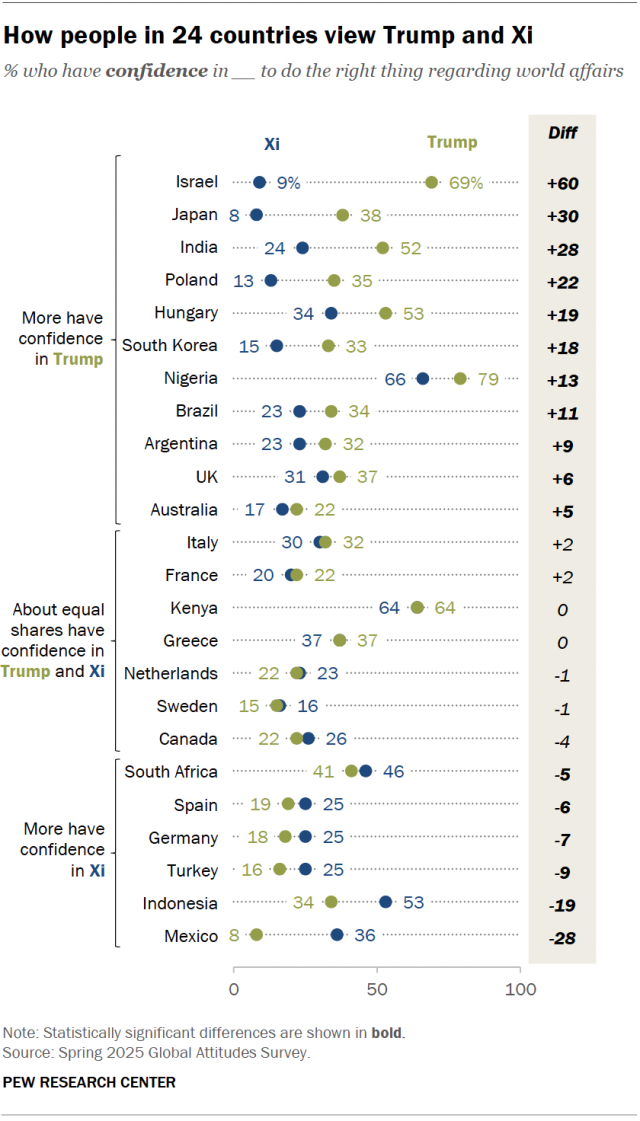
Few people in the countries surveyed have confidence in either U.S. President Donald Trump or Chinese President Xi Jinping to do the right thing regarding world affairs.
Still, Trump’s confidence ratings are higher than Xi’s in 11 countries. The gap is largest in Israel – where people are nearly eight times as likely to have confidence in Trump than Xi (69% vs. 9%). The gap is also sizable in some of China’s neighboring countries, as well as in Hungary and Poland.
In six countries, more people have confidence in Xi than Trump. This gap is largest in Mexico, where 36% have confidence in the Chinese president and 8% have confidence in his American counterpart. Indonesians also stand out in this respect.
In seven other countries – including the U.S.’s neighbor to the north, Canada – there are no significant differences in views of the two leaders.
How global views of Trump and Xi have changed over time
Pew Research Center has long asked people around the world whether they have confidence in the U.S. president – and in other world leaders – to do the right thing regarding world affairs.
Since 2024, when we asked about then-President Joe Biden, confidence in the U.S. president has decreased in 13 countries and increased in six. Confidence in Xi, meanwhile, has increased in 16 countries and decreased only in Israel.
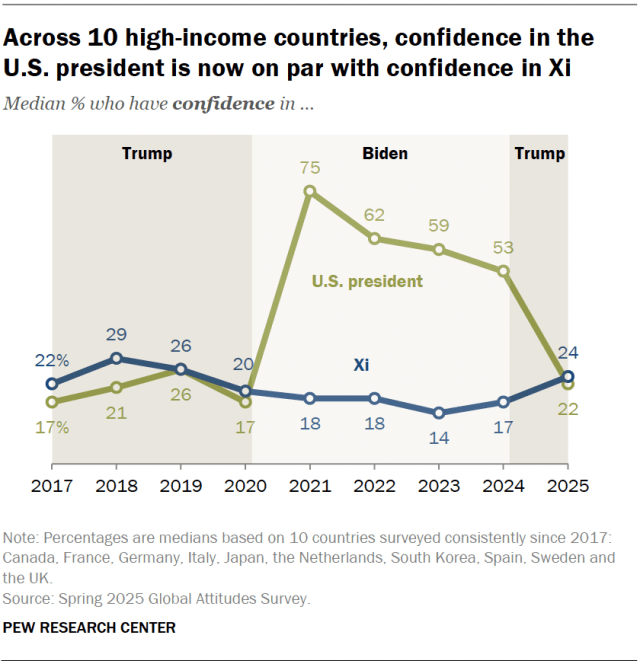
In Germany, 63% of adults expressed confidence in Biden in 2024. This year, far fewer (18%) have confidence in Trump. Over the same period, the share of Germans with confidence in Xi increased from 17% to 25%.
In the 10 countries we have surveyed annually since 2017, median confidence in Biden was consistently higher than confidence in Xi. This year, however, median confidence in Trump (22%) and Xi (24%) are similar. This has not been the case since 2020, the final full year of Trump’s first term.
Which country is the world’s leading economy?
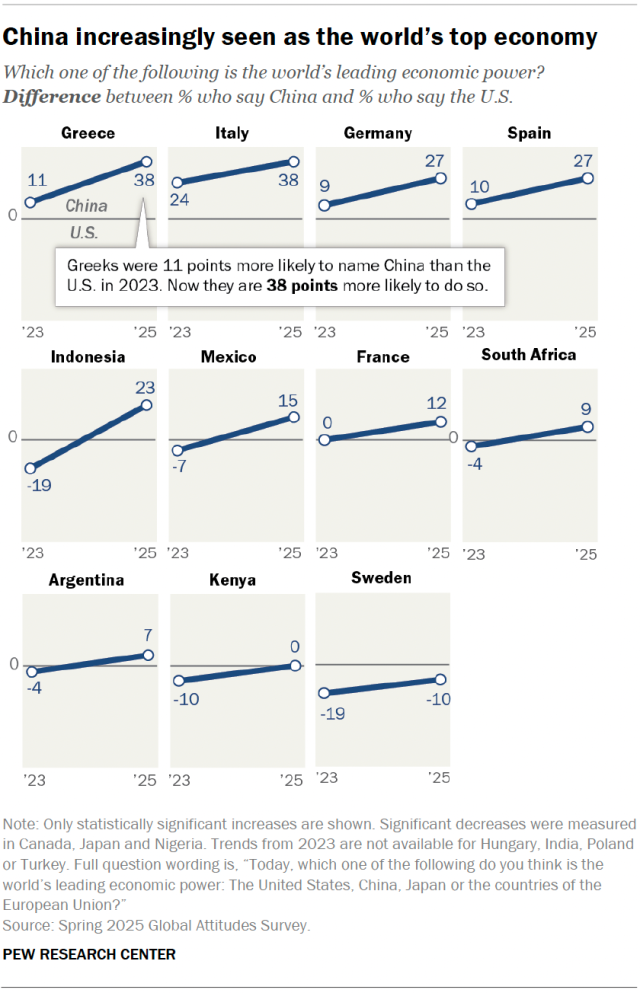
In half of the countries we surveyed this year, more people say China is the world’s top economic power than say this of the U.S. In eight countries, the reverse is true. And in the remaining four countries, people are about equally likely to see China and the U.S. as the world’s top economy.
In some countries, there has been a sizable increase since 2023 in the share of people who say China is the leading economic power – and a corresponding decrease in the share who say this about the U.S.
In France, for example, people were evenly divided in 2023 over whether China (43%) or the U.S. (43%) was the top economic power. Today, more say China is the leading economic power than say this about the U.S. (49% vs. 37%).
The accompanying chart shows the countries where responses on this question have moved toward China since 2023.
Is the U.S. or China a more important economic partner?
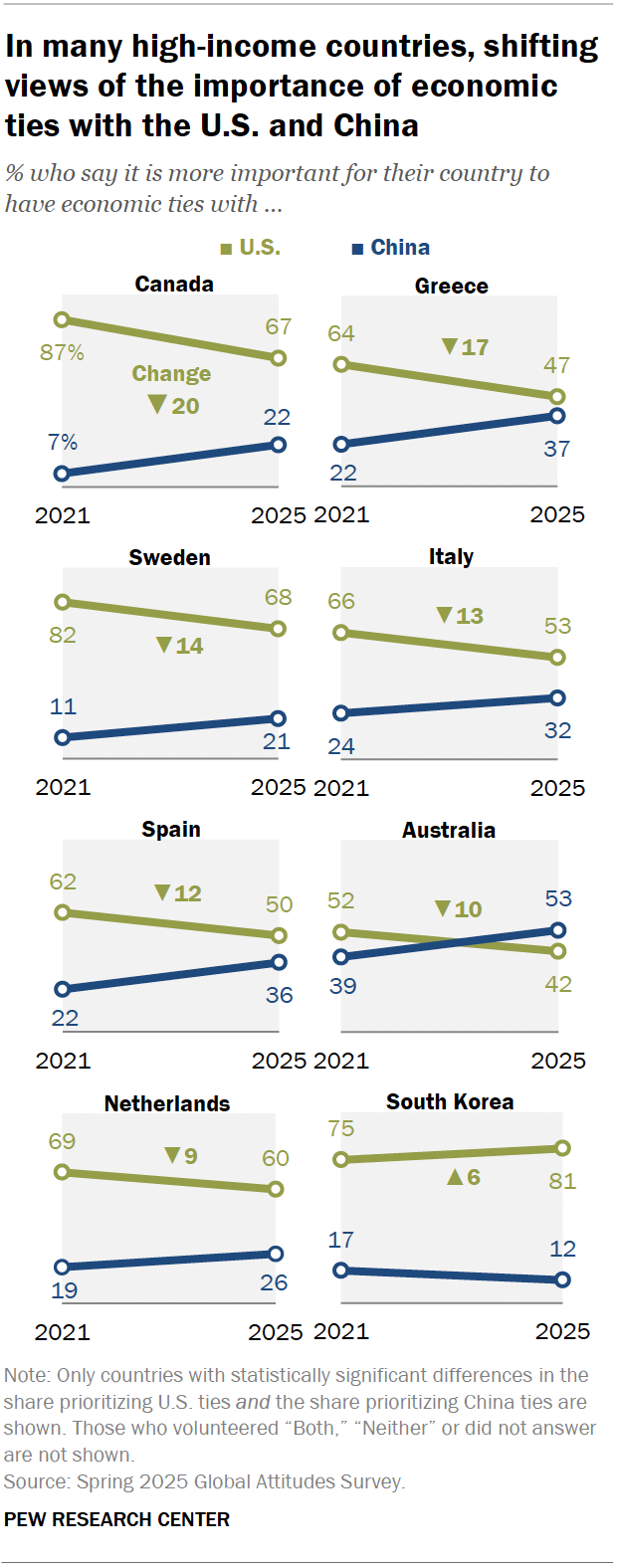
When asked whether it is more important for their country to have strong economic ties with the U.S. or China, more prioritize the U.S. in 19 countries. Only in Australia, Indonesia and South Africa do people prioritize ties with China.
However, in nearly all high-income countries where we asked this question in both 2021 and 2025, views have moved in the direction of China.
In Australia, for example, 52% of adults said in 2021 that it was more important for their country to have close economic ties with the U.S., while 39% prioritized close ties with China. This year, 42% of Australians favor close economic ties with the U.S. and a considerably larger share (53%) place more importance on ties with China.
The opposite pattern appears only in South Korea. The share of South Koreans who say it is more important to have close economic ties with the U.S. increased between 2021 and 2025, while the share prioritizing China decreased.
Which country is a closer ally – or a bigger threat?
We also asked people to name their country’s most important ally in an open-ended question. Adults in most countries surveyed are more likely to say that the U.S. is their country’s most important ally than to say this about China.
But when it comes to which country is the greatest threat to their own, people in most European and Latin American countries surveyed also tend to name the U.S. over China.
In France, Germany, the Netherlands, Sweden and the United Kingdom, the U.S. is the second-most commonly named threat (after Russia). People in Spain name the U.S. as their top threat about as often as they name Russia. The U.S. is the most commonly cited threat in Argentina, Brazil, and Mexico.
In Australia, Japan and the U.S., by contrast, people name most frequently name China as the country posing the greatest threat to their own.
Related: People in Many Countries Consider the U.S. an Important Ally; Others See It as a Top Threat
Note: Here are the questions used for this analysis, along with responses, and its methodology.

